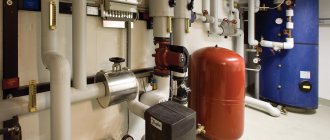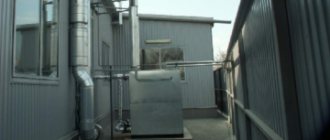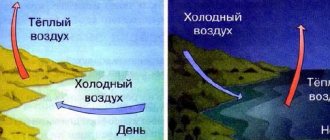Generation of new heating systems
Modern models of gas boilers are more advanced in comparison with traditional analogues.
Both single-circuit and double-circuit devices are available on sale. The first ones are intended only for heating. The latter are capable of simultaneously performing two functions: heating the premises of the house and providing its owners with hot water supply.
Scheme: arrangement of single-circuit and double-circuit boilers
Innovations concern not only the design of the device itself, but the use of higher quality devices:
- The design now includes control and regulating devices that allow you to set different modes.
- In the ignition system, traditional handles have been replaced by piezoelectric elements.
- The casing coating is characterized by increased resistance to damage and durability.
They are convenient because they are able to operate smoothly and efficiently, without requiring constant human supervision. Sensors located on the body will indicate malfunctions, while at the same time identifying the system that has failed.
Thanks to the automatic AGV, in the event of a drop in gas pressure, unexpected extinguishing of the pilot flame or a decrease in draft, the system is instantly switched off, which is important for the safety of residents
- The main elements of the automation unit are:
- Electromagnet – controls the gas supply valve;
- Thermal sensor – controls water heating;
- Draft sensor – monitors the draft level in the pipe;
- Thermocouple – creates an electric current in a circuit.
Modern boilers are as compact and automated as possible
The gas supply to the burner is controlled by a thermal sensor. To ensure uninterrupted operation of the unit, you just need to set the desired parameters. When the shutter is automatically activated, the gas supply to the burner is reduced to a minimum, and the operation of the system is maintained only by a weakly burning wick.
As soon as the temperature sensor triggers to lower the temperature of the coolant, the automation starts and the wick ignites.
Installation of a wall-mounted gas boiler
Diagram of a gas floor boiler.
Tools and materials:
- welding equipment;
- level;
- pencil;
- container for mixing the mixture for concrete screed;
- drill with a set of drills;
- metal scissors;
- screwdrivers;
- a set of keys.
- The height of the suspension of gas equipment along the edge of the lowest pipe must be no lower than the top of the sink spout and no less than 80 cm from the floor.
- The space under the boiler must remain free.
- There should be no cavities in the installation room that could become a place for the accumulation of combustion products or an explosive gas mixture.
- A strong fireproof metal sheet measuring 1x1 m should be laid on the floor.
- An expansion tank and an air valve are installed at the highest point of the system.
Installation diagram of a wall-mounted gas boiler.
When purchasing a boiler yourself, check the contents and availability of fasteners; if not, they should be purchased separately
Pay special attention to the availability of equipment certification, otherwise, after installing it yourself, you will not be able to register it; also check that the serial number in the accompanying documents of the boiler matches the number printed on the inner surface of the boiler
If the wall that will become the basis of a wall-mounted boiler is made or finished with highly flammable material (paper wallpaper, wood), a heat-resistant coating with a layer of at least 2 mm is laid on the surface. The boiler is installed at a distance of 4-5 cm from the wall level. Before installation, rinse the internal tubes by running water under low pressure. Thanks to this washing, it is possible to remove from the tubes all kinds of debris and dust that could have entered during assembly.
When starting installation yourself, attach the mounting strips at a height of 1-1.6 m from the floor. Check the position of the slats with a level and only then hang the boiler itself. Install a hard filter on the water supply pipe to prevent possible clogging of the heat exchanger. Thanks to the installation of shut-off elements on both sides, the filter can be periodically replaced without draining water from the system or cleaned.
Install the chimney and check the draft. Despite the fact that most modern wall-mounted boilers do not require strong draft, since combustion products are removed using a special fan, it is necessary to make sure that the draft is not reverse.
Connect the boiler to the pipeline using a threaded coupling from the side end. The water supply pipeline is connected from above, the water return - from below. The most convenient connection method is gas welding. Do-it-yourself installation rules allow for a slope of heating pipes within 5 mm per 100 cm of pipe.
To connect to the gas pipeline, the participation of a gas specialist will be required. A gas supply valve must be installed on the gas supply pipelines; to connect the boiler to the pipeline, the gas supply through the air line must be shut off. The gas supply is carried out using a metal pipe through an element such as an American pipe or a special squeegee, so this work can only be carried out by specialists.
If the boiler is volatile, it is equipped with automatic equipment that protects against short circuits and overheating, and requires connection to the electrical network.
At the final stage of connection, the boiler is put into operation with your own hands, which can only be carried out by a gas industry worker after checking compliance with the rules and safety requirements.
How it all began
At one time, gas boilers of the AGV-80 or AGV-120 brand were used to heat a private house. This equipment had low productivity, but given the low cost of gas, this fact did not bother anyone.
AGV gas boilers for private homes were equipped with primitive automation, which failed in the first year of operation. However, the equipment functioned normally without it.
Installation of pipes for distribution is carried out outside around the perimeter of the house. However, this issue was not relevant at that time, and heat was supplied to the house in full. Pipes were used with a diameter of 2 inches, since a smaller diameter could cause the formation of air pockets that impede the natural circulation of the coolant.
After a slight modernization, gas boilers for heating AOGV and AOKGV appeared on the market, but this equipment was characterized by the same shortcomings (low performance and unreliable automation).
Despite this, boilers of this type have held up quite confidently on the market due to a serious advantage: the AGV heating stove operates without being connected to a power supply.
Other advantages of a heating system using AGV include the following:
- If we compare imported equipment and AGV, we note the affordable cost of the latter option.
- In contrast to the AOGV and the gas boiler produced by domestic manufacturers, the efficiency of the AGV can be noted.
The listed characteristics help in deciding what is better: an AOGV or a boiler.
This is interesting: A stove with a fireplace designed for long-term heating - how to choose for a summer house. Types, models, burning duration and other characteristics
How to choose the right boiler?
If there is a need to purchase a new boiler, then the choice should be made in favor of one that would comply (if possible) with all current safety standards. First of all, figure out exactly what power you need in order to ensure optimal temperature conditions in the house.
This is very easy to do, now you will understand everything yourself: for ten square meters of room that needs to be heated, there are ten kilowatts of boiler power. These figures are very average, because, for example, modern AOVG-29 devices are capable of heating a room whose area reaches 280 square meters!
Let’s not forget about such an unpleasant moment as heat loss. If your doors and windows are old and they give off cold air in the winter, then it is much better that the selected boiler has a kind of “reserve”.
Pay special attention to automation; keep in mind that domestically produced boilers are cheaper than their imported counterparts.
And remember: connecting the boiler must be done by a gas service employee, who, in fact, will register all this. It is strictly not recommended to do this yourself, since improper installation can cause not only reduced power, but also general breakdown.
About AGV in apartments
The times have come that many residents of apartment buildings prefer to completely abandon the centralized heating system and install AGV heating. But it is worth remembering that installing such boilers is not possible in all types of buildings. This requires, first of all, obtaining permission from the relevant services, and this is much easier to do for old houses with a small number of floors.
The point here is that in such houses, large chimneys with the appropriate pipe diameter, which were still used for heating with a stove, have mostly been preserved. Also, the diameter of the underwater water pipe must be suitable.
But it happens that there are no such chimneys at all. Sometimes they give the go-ahead for the installation of so-called “removable” chimneys, which will be discharged through a hole in the wall. If this is not done, then the heating pipes must be equipped with special casings for thermal insulation. But in general, the current legislation of the country prohibits the transition to autonomous heating, with only rare exceptions.
Composition of the AGV system
The AGV system for heating devices consists of the following main elements:
- AGV boiler;
- pipelines;
- heating elements (radiators, registers);
- expansion tank, which is mounted above all other elements (necessary when starting the AGV heating system).
The basis of the AGV is the AGV boiler. It is a tank mounted in an iron casing, inside of which a pipe for burning gas is mounted. It looks like a samovar. The combusted gas heats the water flowing inside the tank. Gas combustion products are released into the atmosphere through the chimney.
The heated water enters the heating system, where, in accordance with the known laws of physics—hot water is lighter than cold—it flows through pipelines into heating radiators. There, having given up thermal energy, it cools and again enters the AGV for heating. This creates a closed circuit through which the coolant flows by gravity. Its driving force is the difference in height between the heating (AGV) and cooling devices (radiators). The greater this difference, the more intense the water circulation. Such a heating system is called a thermosiphon or a system with natural circulation of coolant. However, recently heating systems with forced water circulation have become increasingly used. In this case, a circulation pump is installed at the outlet of the AGW into the pipeline, which significantly increases the rate of water circulation and, as a result, reduces the time for heating the premises at a given temperature and the consumption of gas consumed. In this case, automation is used that maintains the specified parameters and monitors the fulfillment of basic safety requirements (switching off the gas supply when the water pressure in the line decreases or the burners go out).
Tips for operating a heating system with an AGV boiler in a private house
Operation of AGV requires compliance with precautionary measures for the safe operation of the system:
- A decrease in water temperature to 50 degrees leads to abundant release of condensate, the accumulation of which can cause the burner to go out.
- When condensate combines with combustion products, acid is formed, which negatively affects the metal parts of the boiler.
- Water in the system, cooled to 50 degrees, stops moving naturally in the system.
- If you plan to have a long break in the operation of the heating system, then it is necessary to drain the water. However, it should be remembered that the pipeline in this form is more susceptible to corrosion.
- Hot water in the AGV system is available without heating the entire system. For this purpose, a special tap is used to shut off the water circulation in the heating system. In order not to stop the flow of the coolant, you can make a direct connection between the supply and return pipes.
Operating principle of AGV
The main structural element of the AGV is the container in which the coolant is heated. When gas burns, a heat exchanger, made in the form of a pipe and installed inside the AGV housing, heats up. The heat from the heated pipe is transferred to the coolant, which is subsequently sent to the heating circuit.
Gas combustion products are discharged through a chimney built into the boiler design. All automation is a valve that opens the gas burner. Thanks to the operation of the valve, the required temperature is constantly maintained in the tank.
AOGV boilers also have an automation unit that turns off the device in case of a number of problems:
- Traction disorder;
- Significant reduction in gas supply pressure;
- The igniter stops burning.
- Expansion tank;
- Heating devices located in each room requiring heating;
- Main pipeline providing distribution of heated coolant;
- Upper pipe distribution;
- Return pipe.
To know how an AOGV gas boiler works, you need to imagine the physical laws that arise in the heating system during its operation. The heated coolant has a lower density, which allows it to independently rise above the cold liquid. The coolant enters the main pipeline, is carried through the heating devices, gives off heat to them, and returns to repeat the heating cycle.
In AOGV boilers, the liquid moves by gravity, without any additional effort. If during the heating process the coolant expands too much, then its excess is drained into the expansion tank. This element is installed on the uppermost section of the heating circuit. When the temperature in the circuit decreases, the coolant returns to the OGV gas boiler.
To increase the efficiency of the system and make it more stable, you can supplement the AGV with a circulation pump, which forces the coolant to move forcibly and ensures more uniform heating of all sections of the circuit. It must be remembered that the pump requires electricity to operate - and the main advantage of the AGV is its independence from electricity.
What is the difference between AGV and AOGV
AGV boilers from the city of Zhukovsky can be considered the same technical rarity as UAZ cars. Moreover, they are similar in reliability and ease of operation.
Initially, gas boilers AGV-120 and AGV-80 were produced. The number in the abbreviation is the volume of water in liters. It characterizes the power of the boiler, which is convenient for the average user, since the number coincides with the maximum possible heated area.
Modern gas boilers AOGV (the abbreviation stands for “Gas Water Heating Unit”) are more efficient devices, the power of which ranges from 11.6 to 29 kW. The number in their model index indicates precisely this parameter, and to determine the possible heated area it must be multiplied by 10. Their design has undergone slight changes. For example, the flame tube is made cone-shaped and divided into three sections (number 3 in the index), which made it possible to increase the efficiency of the device from 0.8 to 0.9. In addition, some models are equipped with an additional water circuit (water heater) used for hot water supply. Its presence is indicated by the letter “K” in the index - AKGV.
For user convenience and expanded choice, boilers are available in three types of equipment:
- Economy - all fittings and automation are made in Russia.
- Station wagon - imported automation is used in the most critical units.
- Comfort - all fittings and automatic devices are made in Italy.
Table. Technical characteristics of AOGV boilers produced by Zhukovsky Machine-Building Plant
| Characteristic | Model | ||||||
| AOGV-11.6-3 | AOGV-17.4-3 | AOGV-23.3-3 | AOGV-29-3 | ||||
| Burner power (kW) | 11,6 | 17,4 | 23,3 | 29 | |||
| Heated Smax (m2) | 116 | 174 | 233 | 290 | |||
| Fuel | Natural or liquefied gas | ||||||
| Working gas pressure (Pa) | 1274 - natural 2940 - liquefied | ||||||
| Heating efficiency (%) | 86 | 88 | 88 | 89 | |||
| Operating pressure in the boiler (kPa) | 100 | ||||||
| Dimensions (mm) | 850×310×412 | 1050×420×480 | |||||
| Weight (kg) | 30 | 49 | 52 | 55 | |||
| type of instalation | Floor | ||||||
| Gas outlet diameter (mm) | 117 | 135 | 140 | ||||
| Diameter of lines (gas-heating) in inches | ½ — ½ | ¾ — 2 | |||||
Turning on the gas boiler
A prerequisite for warranty service of a gas boiler is that the first switch-on must be carried out exclusively by a specialist from the gas service. If the user follows all instructions and safety precautions when starting up independently, then you can also count on the reliability and durability of the heating system.
The initial start-up of a wall-mounted boiler is carried out strictly after checking the following points.
The first thing you need to do is make sure that the gas pipes are tight when the gas valve is closed and open. If gas flow is not recorded within 10 minutes after connecting all pipes, then it can be stated that the system is sealed.
The gas supplied from the main pipeline must meet the requirements specified in the instructions for the boiler. When transferring the unit to process a liquefied mixture, you need to change the nozzles in advance.
You also need to check the pressure level in the system. It should be as recommended. The air intake and carbon dioxide exhaust pipes should be checked for blockages.
Sometimes users encounter the problem of poor circulation of the pump. Often the cause is low mains voltage. This problem is solved by installing a stabilizer
It is necessary to make sure that the room with the boiler has a working ventilation system. Additionally, the smoke pressure safety switch is checked.
After carrying out the preliminary work, the procedure for starting the boiler follows:
- The gas boiler is connected to the network, the gas supply to the device is opened;
- Check that all valves at the inlet and outlet of the coolant into the unit are open;
- Press the button or turn the switch on the boiler dashboard depending on the switching method specified in the instructions.
You can adjust the temperature using the corresponding buttons. Working in automatic mode, the boiler independently turns on the burner if it is necessary to heat the water in the system. If the boiler is double-circuit, then when hot water is turned on, the burner automatically turns on for heating.
On the boiler display, after the initial start-up, it is recommended to configure all boiler parameters. The instructions usually indicate the sequence of necessary actions.
The interlock system cuts off the gas supply if the burner does not ignite within approximately ten seconds. When starting for the first time, it may be necessary to remove the ignition lock due to the presence of air in the gas line. You need to wait until the air is replaced by gas. The lock is removed when the device is restarted.
To start a floor-standing gas boiler, you need to carry out the same preparatory procedures as for a wall-mounted one. Before starting up, you need to ventilate the boiler room, make sure that all heating pipe taps are open and that there is draft in the chimney. You can check the traction using a piece of paper.
There are two options for turning off a floor-standing gas boiler. You can turn off only the main burner or the main burner together with the pilot
Switching on the floor-standing boiler:
- The door of the device is opened, the position of the boiler control knob is checked in the off position.
- The gas supply valve opens.
- The control knob is set to the piezo ignition position.
- Next, press the handle for 5 - 10 seconds so that the gas passes through the pipes and displaces the air. The piezo ignition button is pressed.
- Then the presence of a flame in the burner is checked. If the burner does not light, the procedure is repeated.
After igniting the main burner, you can use the control knob to adjust the heating temperature.
User manual
Activating the system is a rather complex procedure, so we will provide step-by-step instructions for using it.
- First you need to pour water into the device and check whether there is traction in it. You should also make sure that the temperature control lever is closed.
- Next, open the tap to supply gas to the boiler.
- We open the viewing window - to do this you need to move a special flap.
- We tighten the air regulators.
- We light the piece of paper, press the activation button and, holding it in this way, bring the burning piece of paper to the igniter through the window.
- After thirty to sixty seconds, the button should be released, and the fire on the igniter should remain. If this does not happen, the operation is repeated.
But the main burner is ignited as follows:
- Turn the temperature dial until the main burner lights up.
- Adjust the air supply until the fire turns bluish.
- We set the temperature mode we need.
Important! To avoid “popping” noises when a fire occurs, make sure each time that the temperature and air regulators are in the full position
New generation of AGV devices
The main model produced at Russian factories is AOGV-23.2-1 (domestic gas heating apparatus). It is designed to heat houses with an area of 140-200 square meters. There is a device with less power, designed to heat areas of 100-140 m2. In appearance, these two brands are practically no different from each other.
Not so long ago, manufacturers began to offer a new combined model AKGV-23.2-1 with a water circuit. This unit can be used both for heating the house and for organizing the supply of hot water. Its filling has also changed. Instead of a pipe running inside the boiler, manufacturers began to install three steel sections. They are made by stamping and are hollow inside. The sections are mounted vertically, connecting into one chimney, through which gas combustion products enter a separate chimney pipe.
The most amazing thing is that water for domestic needs is heated using a coil that encircles the entire circuit inside the boiler. Water flows through it, which is used for everyday life. And in the boiler itself the water for heating is heated. An excellent device, so to speak, two in one. By the way, the coil is made of copper pipe.
An injection burner has been added to the kit of the new model, ensuring efficient combustion of gas without residue. This type of burner works great even if the gas pressure in the pipeline drops.
AKGV-23.2-1 with water circuit
Special conversation about the automation of the new AGV. This is a unique system that completely controls the entire water heating process. The automation unit consists of:
- Thermal sensor that controls the water temperature;
- An electromagnet responsible for controlling the main gas supply valve;
- Thermocouple, which is installed near the igniter. It is heated by a constantly burning torch, thereby creating an electric current in the circuit. And the current guarantees that the gas supply valve will always be open;
- A draft sensor, which is mounted in the chimney and monitors the effective draft of the pipe.
In general, the automation unit will never give you the opportunity to play a cruel joke on you if one of the indicators of the boiler’s efficient operation suddenly goes wrong. There will be no fire or gas leak. The most important thing is that the automation is correctly adjusted.
Speaker repair
AGV – 80 gas heating boiler. Technical characteristics of agv-80:
- Heat load 6000kcal/h
- Water temperature setting 40 - 90gr/C
- Heated room area up to 60m2
Main components of the AGV-80 heating boiler.
- Galvanized tank (80 liters), thermal insulation, min. cotton wool. In the center of the tank is a flame tube with a heat flow extender.
- The main burner, in front of it, the tap regulates the gas supply.
- Automatic security.
- For flame, solenoid valve, thermocouple, igniter.
- For draft, tee, connected pipe, draft sensor.
- Temperature-thermostat.
Boiler solenoid valve. The boiler solenoid valve consists of two parts: gas and electromagnetic. There is a membrane between them. The thermocouple consists of two metals, chromel and copel, welded together. The flame heats the boiler thermostat, generating an electric current that magnetizes the core. By pressing the start button, the armature is pressed against the core by a pusher, while the paired valves move inside the gas part, opening the gas to the boiler igniter and compressing the return spring. At the end of the thermocouple warming up for 60 seconds, you must smoothly release the boiler button; under the action of the return spring, the paired valves are shifted back - 2.3 mm. Gas opens to both the igniter and the main burner of the boiler. The valve cannot return completely to its original position. They are held by an anchor magnetized to the core. If the igniter goes out, then the thermocouple of the heating boiler cools down and the magnet releases the armature; the return spring pushes the valve to its original position, no gas flows to the burner.
Malfunctions of the gas heating boiler AGV-80
- Contamination of the surface of the core and armature (clean, degrease)
- Thermocouple burnt out (Replace)
- No electrical contact.
Automatic traction (with gas removal from the igniter)
Gas from the electromagnetic valve of the heating boiler flows through the tee to the igniter, as well as through the connecting tube to the draft sensor installed under the hood of the device. The draft sensor is a bimetallic plate with a plug, which, during normal draft, closes the gas from the connecting tube. When the draft is covered, combustion products come out from under the hood and heat the bimetallic plate. It unbends, the plug opens the gas from the connecting tube, and gas is supplied to the igniter. Response time from 10 to 60 seconds.
Gas boiler thermostat. Operation accuracy 5gC, thermostat parts.
- Frame.
- Toggle lever system.
- Valve with spring.
- A brass tube with an invectar rod is screwed into it.
- Lever for thermostat.
When the water in the tank is heated, the brass tube lengthens, but the intar rod does not. The rod moves behind the tube and stops pressing on the system of closed levers, which, under the action of a spring, closes the valve with a click, blocks the passage of gas to the burner; when the water cools, the brass tube shortens; the rod presses on the levers, they close and turn off the valve. When the setting lever is rotated counterclockwise, the response temperature increases.
Malfunction of the boiler thermostat.
- The thermostat does not work and cannot be adjusted: The lever system has stretched or burst.
- The large or small levers are deformed.
- The supporting edges of the levers are worn
The thermostat operates but does not stop the gas supply: The valve stem sets the guide bushing.
AGV, or automatic gas water heater, is an element of the heating system, thanks to which it becomes easy to operate along with a fairly long service life. However, the presence of these characteristics is possible only if the gas boiler is properly installed and properly maintained.
Epilogue
In conclusion, it is worth recalling that the repair of AGV, along with the maintenance of gas boilers, are quite difficult operations that must be carried out by specialists. Only by observing this condition can the risk of damage to housing and injury to its inhabitants be eliminated.
Repair of AGV, OAGV, gas heating boilers 8-903605-49-99
Generation of new AGV systems
Some units are produced at Russian factories. One of them is AOGV-23.2-1, which structurally looks like a household heating cylinder. It is used in houses with an area of 140-200 square meters. There is a unit with a lower heating power - approximately 100-140 square meters. Apart from power, these two devices are no different from each other.
Recently, a new system was released called AKGV (Combined Gas Water Heating Apparatus). According to the method of use, it is no different from AGV; it is used both for heating the house and for supplying hot water. But the design of the AKGV unit is different - instead of a pipe that goes inside the boiler, three steel sections are installed, which are stamped in a special way, they are mounted in a vertical position and connected into one chimney.
This device is rightly called “two in one”, because it initially heats the water using a coil, which is encircled along the entire contour of the boiler. The water flowing through the coil is used for domestic purposes, and in the boiler the water is heated for heating.
The newest models have an injection burner. It ensures gas combustion without residue and works even when the gas pressure drops.
Automation of the new AGV
This irreplaceable item fully controls water heating and consists of:
- Thermal sensor, which gives the system an idea of the current temperature;
- Electromagnet - valve control device;
- Thermocouples, which are installed next to the igniter and are responsible for generating electric current when heated from the torch;
- Traction sensor. It is installed in the chimney to control draft.
With proper adjustment, the automation unit will prevent sudden shutdown of the AOGV in the event of a breakdown or failure in the boiler settings, and most importantly, will extend its service life.
If we talk about the origins, this type of heating equipment was developed back in the 50s, due to the lack of central heating in villages, villages and small towns. Since then, AGVs began to systematically gain popularity, and soon most houses in the USSR began to be heated with them. Thus, this system, of course, after modernization and modifications, fits well into modern realities
It is only important to know how to choose AGV heating, remember the rules for handling this system and follow them, then the boiler will serve you much longer than its declared service life. After all, the system in which hot water circulates does not tolerate jokes and amateur activities. In general, this system is quite economical both in terms of funds and in terms of space occupied
And with the introduction of ACS (Automated Control Systems), its operation and maintenance does not cause any trouble at all. After proper setup, according to instructions or with the help of a specialist, the coefficient of intervention on your part becomes minimal, and guarantees warmth to your home
In general, this system is quite economical both in terms of funds and in terms of space occupied. And with the introduction of ACS (Automated Control Systems), its operation and maintenance does not cause any trouble at all. After proper setup, according to the instructions or with the help of a specialist, the coefficient of intervention on your part becomes minimal and guarantees warmth to your home.
Criteria for choosing wisely
The efficiency of the system largely depends on the correct choice of gas boiler. The determining factors when choosing an AGV installation are:
- The area of the heated room.
- Unit power.
- Possible heat loss.
The range of standard AGW power values is quite wide: from 11 kW to 35 kW and above.
Tip: The optimal power parameter of the device is calculated using the formula. To do this, 1 kW of unit power is divided by 10 sq.m of heated premises area.
Heat loss largely depends on the type of building materials used in the construction of the house. If materials with high heat losses are used in the construction of a building, then an additional 25% is added to the initial power of the unit.
The specific power is determined by the climatic characteristics of the area and is calculated for each region separately. For example, for northern regions, characterized by lower temperatures in winter, it is 1.5-2 kW. For southern regions - from 0.7 to 0.9 kW.
Of no small importance is the value of water pressure in the heating system, as well as the value of pipe resistance. To obtain more accurate calculations, experts recommend taking into account the total length of the forward and return pipelines, while setting a coefficient for the resistance of the material.
For heating private houses with an area of 100-200 sq.m, among the models of domestic manufacturers, the most popular types of gas boilers are:
- AOGV – gas water heating device;
- AKGV is a complex gas water heating device.
In addition to the main heating circuit, these devices have a circuit for supplying hot water. The heating of the coolant for water supply in units of this type is carried out through a copper coil, which is located around the perimeter of the tank, and the water for supply to the radiators is heated in the boiler itself.
The main advantage of these systems is their efficiency and low cost. Depending on the modification (floor or wall model), you can choose different installation options. But in any case, a separate room must be allocated for installation of the unit.
Among the significant disadvantages it is worth highlighting:
- Insufficient compactness of equipment. The unit occupies a total room space of at least 1 cubic meter.
- Energy dependence – the need to connect to a power supply.
AGVs from foreign manufacturers, such as RINNAI, FERROLI and ANIERIA, are more expensive. They are famous for their high reliability and ease of operation. In some models, the necessary parameters can be set electronically. But imported units also require an electrical connection.
But in any case, the choice of AGW is determined by the availability of energy resources. The use of automated control systems allows intervention on the part of the owner to be kept to a minimum.
Modernization of AGV boilers by the manufacturer
The boiler manufacturer AGV was in no hurry to discontinue them due to obvious advantages.
However, taking into account that this equipment needed a thorough modernization, the following design changes were made:
- Fragile glass thermometers have been replaced with more reliable instruments made in Italy;
- The new systems were equipped with automation from the American company Honeywell;
- To turn on the device with a handle, a piezo ignition system was used;
- New coating technology has made the appearance of the unit more aesthetically pleasing.
Boiler diagram AOGV - 23
Rules for handling the heating system
The unit is installed in a separate room. It is advisable that this room be soundproofed, since when the boiler burner is turned on, a rather loud bang occurs.
In some new modifications (AOGV-23.2-1-U), this drawback has been largely eliminated, since when the water overheats, the automation does not turn off the burner completely, but switches it to a mode in which the flame is minimal.
A chimney (with a diameter of 140 mm) for combustion products is installed outside residential premises. Below the junction of the pipe from the heating tank with the chimney, there is a garbage container - a “pocket” for foreign objects and waste that accidentally fell into the channel.
Option for a chimney for AGV in a private house
For the unit, a room should be allocated in the lower part of the building. The ascending pipeline needs insulation. The return line should not be insulated.
The installation instructions for heat transfer devices (radiators, convectors and heating panels) provide for their installation at the highest possible height from the unit itself. To circulate layers of air, such devices should be installed under windows. The return pipeline is laid under the floor of the room.
If the return line is laid above the door jambs, airing of the system may occur.
General view of a fragment of the pipe layout of a heating system with AGV
Two-inch network pipes do not look very aesthetically pleasing, however, when replacing them with pipes of smaller diameter, it is necessary to take into account that as the diameter of the pipe decreases, hydrodynamic resistance increases, which weakens the water pressure in the system. This, of course, can seriously impair the performance of such a unit.
AOGV connection: rear view
During installation, pipelines are installed with a slope of 1 cm for each meter of pipe length. This avoids the appearance of air locks in the system, facilitates water circulation and allows water to be drained from the system.
This video examines some practical issues of installing AGV in a private home:
Some Caveats
- When the water temperature in the system drops below 55-50°C, condensate begins to release abundantly. If it accumulates, it can extinguish burners;
- Combustion products, when mixed with condensate, form nitric and sulfuric acids, which cause corrosion of equipment;
- If the water temperature in the system drops below 50°, then its circulation in the system almost completely stops;
- If the room is not heated in winter, the water from the system must be drained, but in this case corrosion increases significantly;
- To get hot water without heating the entire system, you can use a tap that shuts off the circulation in the heating system. And if you connect the forward and return lines, you can maintain turnover.
Have a warm winter!
AGV gas boilers for a private home - technical specifications
During the existence of the USSR, AGV heating was considered the most popular option for heating private housing, and sometimes the only one. Then gasification covered a significant part of the country and thanks to this the population had the opportunity to abandon stove heating in favor of natural gas.
At first, only AGV gas boilers were used as heat sources for private houses; there were no other options. Despite the fact that subsequently the choice of equipment expanded significantly, these units retained their popularity, and they are still on the market today.
In this article we will look at what features are inherent in these devices.
Criterias of choice
When buying boilers for a private home, several aspects are taken into account:
- The area of the heated room.
- Possible heat losses (depending on the materials from which the walls of the building are constructed, the floors and ceilings, windows and doors are made).
- Equipment power (the required figure is calculated based on 1 kW for every 10 m² of area). But if the house is located in a region with harsh winters or is built from materials with high heat loss, the resulting figure is increased by 25%.
- Functional features of the boiler.
AGVs are produced in different capacities, but the standard indicator is enough to heat a house up to 120 m². For large buildings, foreign autonomous boilers are purchased. Additionally, improved AOGV or AKGV devices are being considered as an alternative solution.
The latter is a complex water heating apparatus. These are double-circuit boilers that operate independently of the electrical network. The units provide heating and hot water supply.
However, experts believe that it is not advisable to install such equipment in houses with an area of 200 m² or more, since it is impossible to create stable natural draft. You will have to buy an additional circular pump, and a UPS and a generator for it to ensure operation. Such disadvantages offset the advantages that the autonomy of boilers provides.
Advantages and disadvantages of AGV
The list of positive qualities of AGV is as follows:
- Independence from electricity. This quality is often fundamental when choosing an AGV. The equipment in question does not require electricity at all to operate, so it will fit perfectly in situations where there are problems with electricity, or if there is a desire to save money on it.
- Cheapness. Compared to any foreign analogues, AGV wins in everything related to the cost of equipment. This advantage remains such even taking into account the extremely low efficiency of autonomous gas water heaters.
- Economical. AGVs are rightfully considered one of the most economical types of gas heating equipment.
The disadvantages of AGV come down to the following list:
- Big sizes. To install an AGV, about 1 m3 of space is required - which is quite a lot. Often a separate room is allocated for the installation of such equipment.
- Appearance. From a visual point of view, AGV is a purely utilitarian thing that does not have the slightest aesthetic value. In addition to the unpresentable appearance of the heater itself, the heating system is necessarily supplemented by large pipes and radiators, so you have to be sophisticated to create a good interior.
Technical characteristics of AGV-120 boilers
From a design point, the gas apparatus of this model includes only a heat exchanger, an expansion tank, a cast iron burner and simple automation. Boilers can be installed where the facility cannot be connected to a centralized heating system.
Such a device, operating on gas, was the AGV-80 boiler. The AGV-120 unit appeared later, then several more modifications were developed. The devices are in demand. They have such advantages as reliability, versatility (the unit is used to heat a room and provide hot water supply), and are also characterized by fuel economy. At the same time, the main components have been modified.
The cylindrical tank is made of galvanized steel, which is resistant to corrosion. Its volume is 120 liters. At the same time, the device is equipped with a piezoelectric element and imported automation, which can increase operational safety. There is an improved ignition system.
The thermal power of the device is 14 kW (however, the heating output is lower - 11 kW). The water does not heat up too quickly: it takes an hour to raise the temperature to 90 °C. The efficiency of modern units is about 85%.
The casing of the device is made of steel sheet. There remains a space between the tank and it, which is filled with slag, which acts as thermal insulation. The device is equipped with a cast iron burner.
Cold water is supplied from below. The selection of hot liquid that will circulate inside the heating system occurs from above.
The return line must be connected to the water supply fitting.
There is a thermostat to change the temperature of the liquid. Its element is located directly inside the tank. To control the burner, a thermocouple and a solenoid valve are installed. There is a fire tube inside the tank, designed to allow combustion products to be discharged outside. This design increases the heating area and improves the heat transfer process.
The best condensing gas boilers
These boilers are considered the most economical because they can use the energy of not only gas combustion, but also condensing steam. As a result, their efficiency is almost close to the coveted 100%.
Vaillant ecoTEC plus VUW
89%
buyers recommend this product
Stuffed with intelligent electronics and eBus switching, the unit works not only for efficient heating, but also for preparing hot water, that is, it also belongs to double-circuit units. The capacitor system is more environmentally friendly compared to the traditional one, and also provides a very high efficiency of 98%.
The combustion chamber is equipped with a modulating burner with wide power adjustment capabilities (from 28 to 100 percent). With such efficiency and equipment, the dimensions of the boiler are quite acceptable: 720x440x372 mm. The ecoTEC line itself consists of three models with a maximum power of 24, 30 and 34 kW.
Advantages:
- Digital control and diagnostic system;
- The most informative panel;
- Possibility of control from a mobile phone and connection to a “smart home”;
- The burner can receive air both from the room and from the street;
- Short-term increase in power for quick water heating;
- Removal of condensate outside.
Flaws:
- Difficult to repair;
- High price.
ecoTEC Plus boilers still scare off many due to their high cost. But there is minimal hassle with them, and the fuel savings will pay off the investment over time.
Viessmann Vitodens 100-W
88%
buyers recommend this product
An expensive boiler, capable of operating at a power of 4.7-35 kW, saves not only blue fuel, but also electricity - due to the adjustable operation of the fan. This model also has other highlights. We are talking about a cylindrical MatriX burner, consisting of many micro-nozzles, which practically does not allow heat loss. A ring heat exchanger made of stainless steel works no less efficiently.
Advantages:
- Compact housing 400x400x350 mm;
- Two ways to prepare hot water;
- Maximum efficiency and energy efficiency;
- High efficiency (98%);
- Intelligent automation;
- Remote control – from a touch panel or smartphone;
- Possibility of working on LNG and biogas;
- Easy access for repairs and maintenance.
Flaws:
Price.
If your home is equipped with a smart home system, the equally smart Viessmann Vitodens will be the best solution for creating a heating and hot water system.
Viessmann Vitopend 100-W A1HB003
Baxi Eco Four 1.24 F
Vaillant AtmoTEC Plus VU 240/5-5
Heating power 34 kW 24 kW 24 kW Type single-circuit single-circuit single-circuit Efficiency 90% 92.9% 91% Combustion chamber closed closed open
Advantages and disadvantages of AGV heating
The list of advantages of AGV is as follows:
- Operational safety;
- High reliability;
- No dependence on electricity;
- Possibility of installing an automation unit;
- Availability of different formats of water heaters (wall-mounted and floor-mounted);
- Simplicity of design, ensuring ease of repair and maintenance;
- Low cost and economical.
Among the disadvantages of ageve for the home, the following qualities can be distinguished:
- Large volume of equipment (the average boiler takes up about 1 m3), due to which it is often necessary to allocate a separate room for AGW;
- Negative impact on the design of heated rooms, which is why you have to carefully think through their interior.
The indicated disadvantages in most cases are not critical, therefore, all other things being equal, AGV will be one of the best options for heating equipment for a private home.









